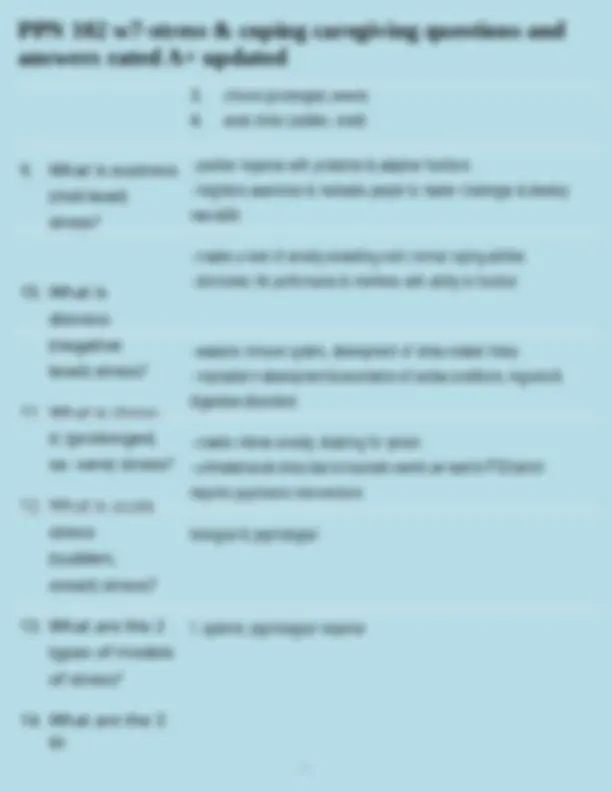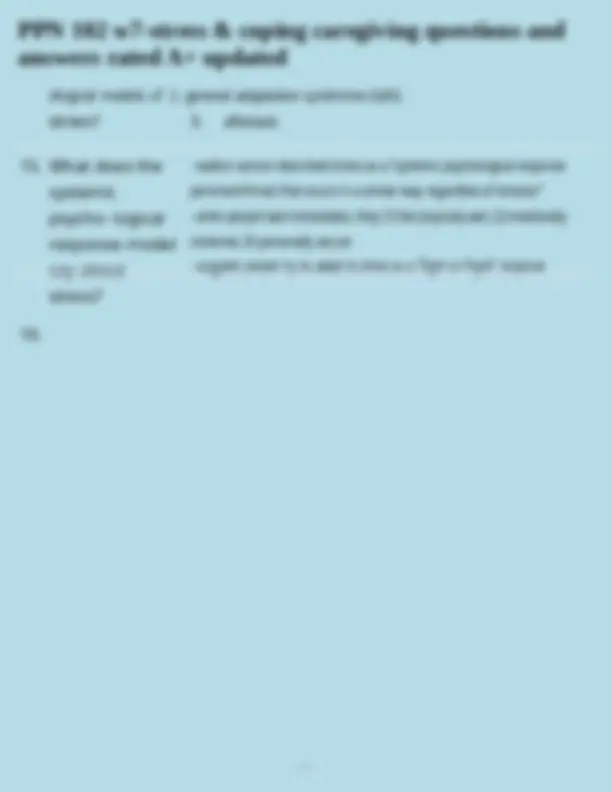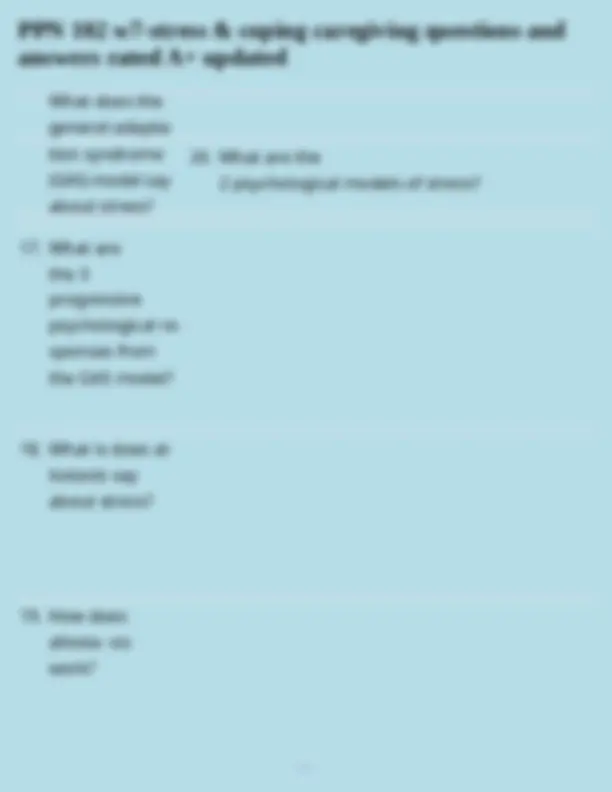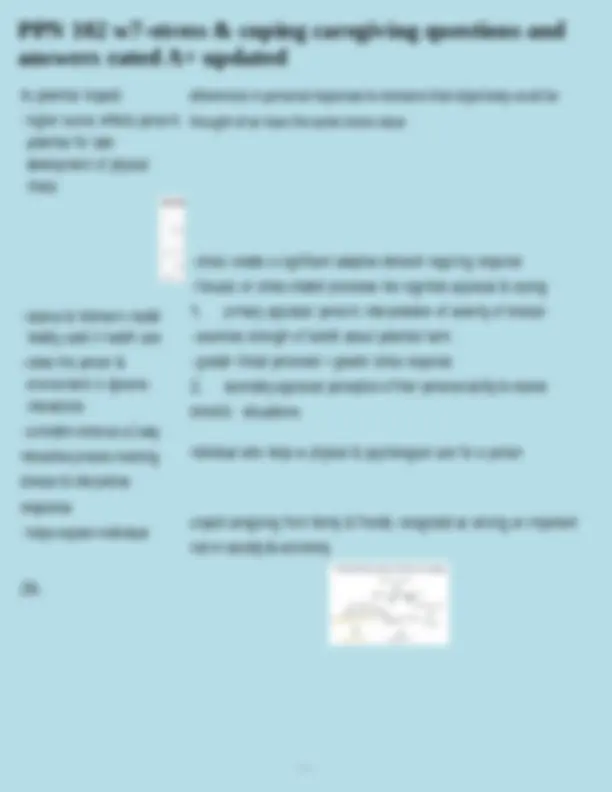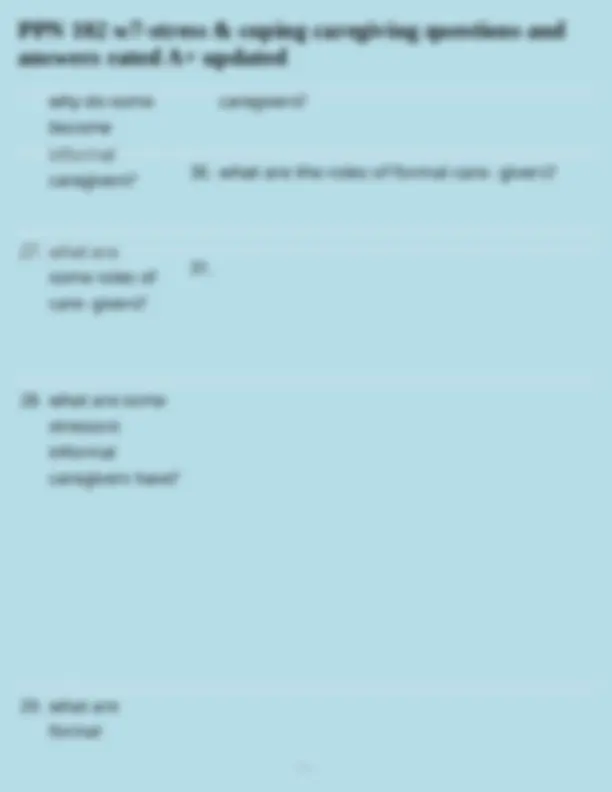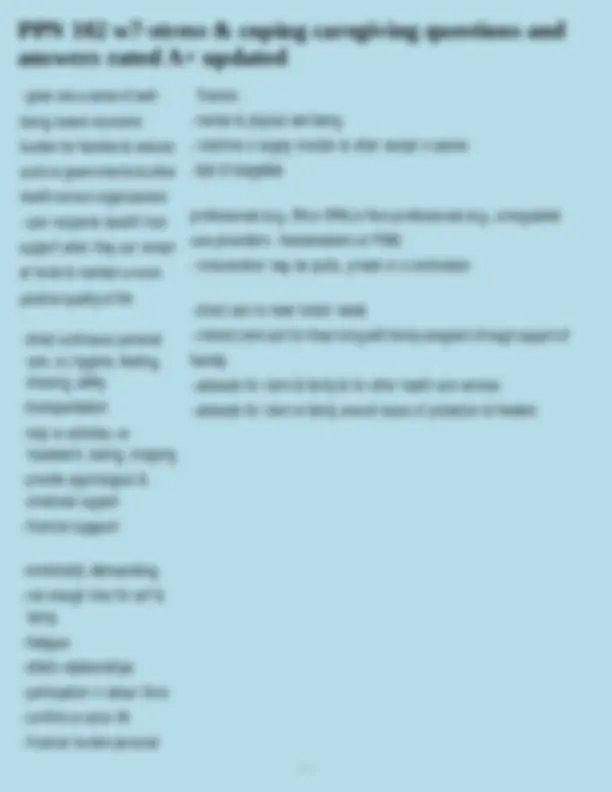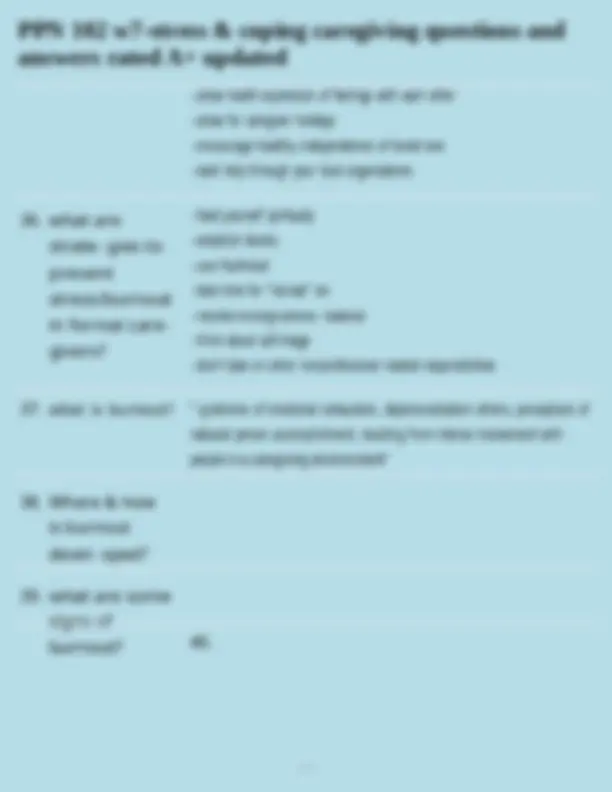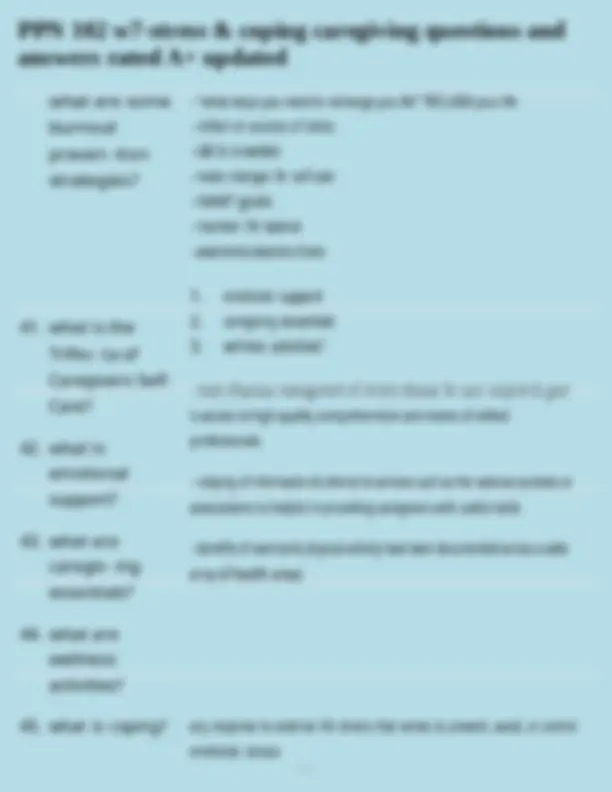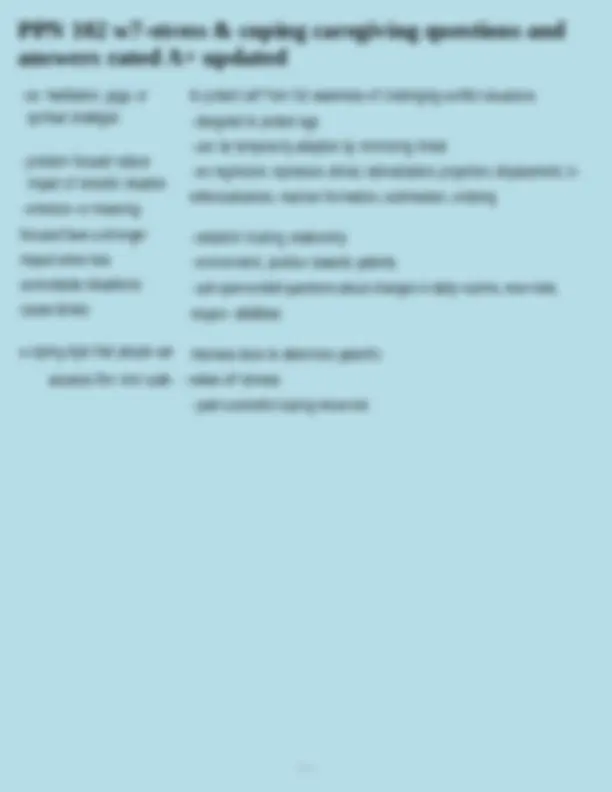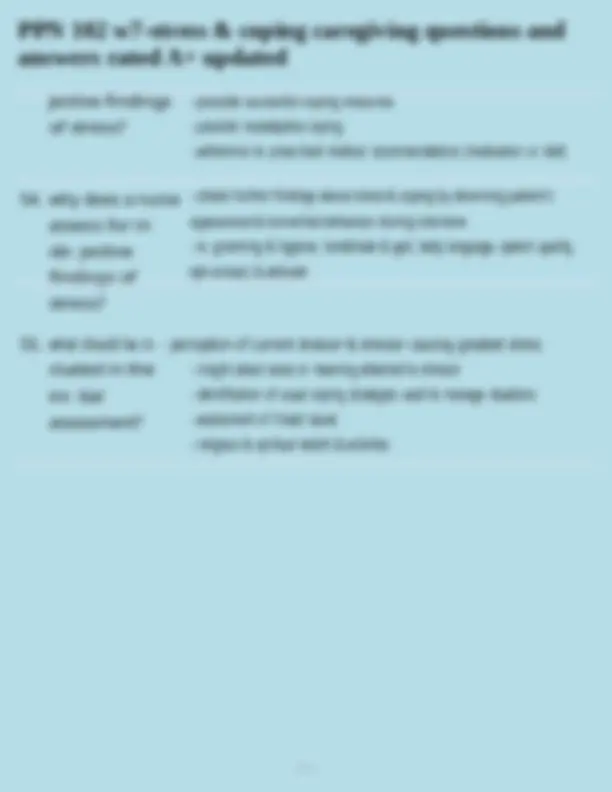Download PPN 102 w7-stress & coping caregiving questions and answers rated A+ updated-16.docx and more Exams Nursing in PDF only on Docsity!
answers rated A+ updated
- What is stress? condition which the body responds to changes in its normal balanced state (homeostasis)
- What is a stressor? anything a person perceives as challenging, threatening, or demanding
- What is adapta- tion?
- What are the 3 types of personal stressors?
- What are some physical stres- sors?
- What are some psychologi- cal stressors? 7. What are some spiritual stres- sors? 8. What are the lev- els of stress? (4)
answers rated A+ updated
changes that take place from a person's response to stress (in response to a stimuli)
- physical
- psychological
- spiritual
- acute or chronic illness
- t r a u m a o r i n j u r y p ain
- insomnia
- mental disorders
- job loss or security
- school
- loss of a significant person or pet
- significant changes in residence, relationship or work
- personal finances
- work relationships
- high-stress work environments
- caretaking
- loss of hope
- purpose lose
- questioning values or meanings
- eustress (mid-level)
- distress (negative level)
answers rated A+ updated
ological models of 2. general adaptation syndrome (GAS) stress?
- What does the systemic psycho- logical response model say about stress?
- allostasis
- walton cannon described stress as a "systemic psychological response perceived threat that occurs in a similar way regardless of stressor"
- when people have homeostasis, they: (1) feel physically well, (2) emotionally centered, (3) personally secure
- suggests people try to adapt to stress w a "Fight or Flight" response
answers rated A+ updated
What does the general adapta- tion syndrome (GAS) model say about stress?
- What are the 3 progressive psychological re- sponses from the GAS model?
- What is does al- lostasis say about stress?
- How does allosta- sis work?
- What are the 2 psychological models of stress?
answers rated A+ updated
What is do criti- cal life events say about stress?
- What is does the transactional model say about stress?
- How is the trans- actional model used?
- What is a caregiv- er?
- what is an infor- mal caregiver?
answers rated A+ updated
its potential impacts
- higher scores reflects person's potential for later development of physical illness
- lazarus & folkman's model ’widely used in health care
- views the person & environment in dynamic interactions
- considers stress as a 2-way interactive process involving stressor & interpretive response
- helps explain individual ditterences in personal responses to stressors that objectively could be thought of as have the same stress value
- stress creates a significant adaptive demand requiring response
- Focuses on stress-related processes like cognitive appraisal & coping:
- primary appraisal: person's interpretation of severity of stressor
- examines strength of beliefs about potential harm
- greater threat perceived = greater stress response
- secondary appraisal: perception of their personal ability to resolve stressful situations individual who helps w physical & psychological care for a person unpaid caregiving from family & friends; recognized as serving an important role in society & economy
answers rated A+ updated
- gives one a sense of well- being, lowers economic burden for families & reduces costs to governments & other health service organizations
- care recipients benefit from support when they can remain at home & maintain a more positive quality of life
- direct continuous personal care, ie.) hygiene, feeding, dressing, safety
- transportation
- help w activities—ie. housework, baking, shopping
- provide psychological & emotional support
- financial support
- emotionally demanding
- not enough time for self & family
- fatigue
- attects relationships
- participation in labour force
- conflicts w social life
- financial burden-personal finances
- mental & physical well-being
- role/time is largely invisible to other except in asence
- lack of recognition professionals (e.g., RN or RPN) or Non-professionals (e.g., unregulated care providers - homemakers or PSW)
- remuneration may be public, private or a combination
- direct care to meet holistic needs
- indirect client care for those living with family caregivers through support of family
- advocate for client & family & for other health care services
- advocate for client w family around issues of protection & freedom
answers rated A+ updated
what are ar- eas of potential burnout?
- What are some concerns related to financial de- pendence & inde- pendence?
- What are some challenges of caregiving in in- formal caregiv- ing?
- what are strate- gies to alleviate stress in informal caregivers?
- what are ways to prevent burnout in informal care- givers?
answers rated A+ updated
- what are strate- gies to prevent stress/burnout in formal care- givers?
- allow health expression of feelings with each other
- allow for caregiver holidays
- encourage healthy independence of loved one
- seek help through your local organizations
- feed yourself spiritually
- establish limits
- use humour
- take time for "recreat" ion
- resolve incongruences - balance
- think about self-image
- don't take on other nonprofessional related responsibilities
- what is burnout? " syndrome of emotional exhaustion, depersonalization others, perceptions of reduced person accomplishment, resulting from intense involvement with people in a caregiving environment"
- Where & how is burnout devel- oped?
- what are some signs of burnout? 40.
answers rated A+ updated
- come from a chronic result
- develops from combined factors in work related environments & within person
- emotional exhaustion
- depersonalization & reduced sense of competence
- sense of diminished professional accomplishment
- feeling disillusioned & lack rest for work
- loss of motivation & ideals
- boredom
- dissatisfaction at work
- high rates of sick leave
- irritability of co-workers
- increased risk of work errors
answers rated A+ updated
- changing cognitive & behavioural ettorts to manage specific external or internal demands
- what are the 3 purposes of cop- ing strategies?
- how are problem- focused strategies used?
- to change stressful situations (problem-focus)
- to change meaning of stressor (meaning-focused)
- to help one relax enough to take the stress in stride (emotion-focused)
- purposeful active, task-oriented methods most ettective in reducing stress
answers rated A+ updated
provide an example
- how are meaning- focused strategies used? provide an example
- how are emotion- al- focused strate-
- ex: confronting a problem directly, negotiating a ditt solution, seeking social support, constructive problem solving & taking actions
- help reframe meaning or significance of stressor so it loses its power
- stressor may still exist, but greater calmness
- ex: think about why one is trying to cope and overcome the stressor
- strategies act in a ditterent way to minimize influence of stress in patient's mind
- ettectiveness as stressor is perceived as overwhelming irreversible situation or gies used? provide person needs despite from overthinking an example
- when are the dif- ferent strategies used?
- what are ego defence mecha- nisms? provide an example.
- how should a nurse assess for stress?
- why does a nurse
answers rated A+ updated
jective findings of stress?
- why does a nurse assess for in ob- jective findings of stress?
- possible successful coping resources
- possible maladaptive coping
- adherence to prescribed medical recommendations (medication or diet)
- obtain further findings about stress & coping by observing patient's appearance & nonverbal behaviour during interview
- ie. grooming & hygiene, handshake & gait, body language, speech quality, eye contact, & attitude
- what should be in- - perception of current stressor & stressor causing greatest stress cluded in the ini- tial assessment?
- insight about value or meaning attached to stressor
- identification of usual coping strategies used to manage situations
- assessment of linked issues
- religious & spiritual beliefs & activities

